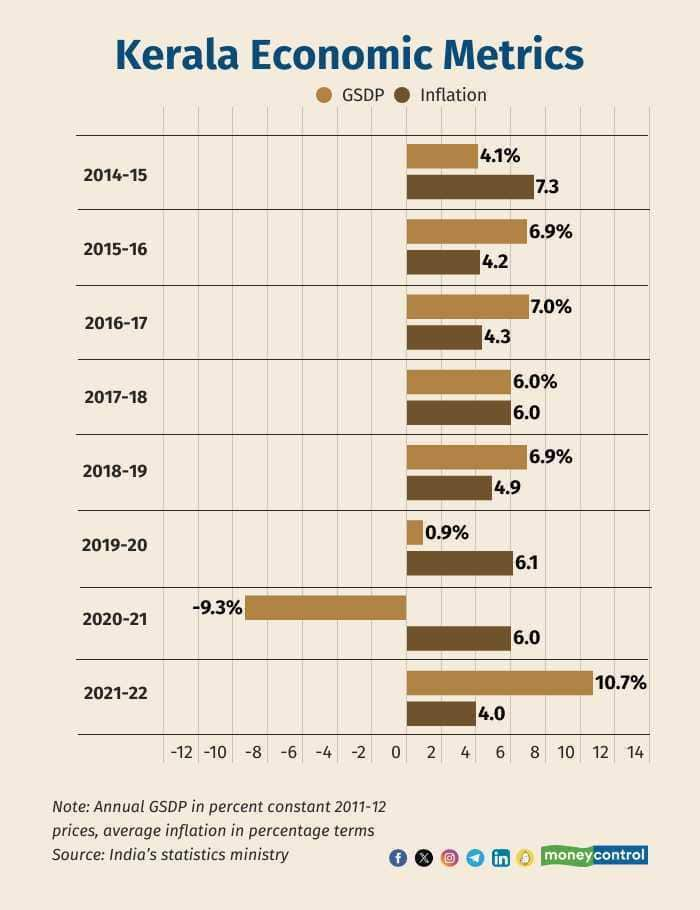



Kerala has been performing well on human development indicators for nearly two decades. Even after the Covid-induced slowdown, Kerala has seen steady growth, with its per capita GSDP increasing 6.06 per cent in 2022-23, higher than the 5.9 per cent growth recorded at the all-India level.
Kerala has performed the best per NITI Aayog’s Multidimensional Poverty Index (MPI), 2023, with a score of 0.002 percent, and has ranked first in the last three editions of NITI Aayog’s Sustainable Development Goals Index (SDGI). It also tops the (Indian) charts on the Human Development Index (HDI), with 7.5 points, as per the state government's Economic Review 2023 released in January 2024.
According to the India Skills Report, 2024, Kerala’s youth aged 18 to 21 are the second-most employable in the country, with Trivandrum, Ernakulam, and Kozhikode ranking among the top 10 cities for talent.
The Kerala model of development has yielded good results in terms of literacy, healthcare, sanitation, and more. It has the highest literacy rate among all states of 93.91 percent, a high life expectancy of 74.9 years, and is open-defecation free.
The state's growth rate has jumped to 10.7 percent in 2021-22 from 4.1 percent in 2014-15, at constant prices. At current prices, the state’s GDP has jumped 100.5 percent in 2021-22, at Rs 9,32,470 crore, compared to Rs 4,65,041.2 crore in 2013-14.
But the state has high debt, making its financial health a matter of concern, and is struggling with an unemployment rate that's higher than the national average, a high suicide rate, poor industrial growth, and battling a mental health crisis, Prime Minister’s Economic Advisory Council (PMEAC) member Shamika Ravi had told Moneycontrol earlier.
Also Read : The other Kerala story: a bleak future for God’s Own Country?
Kerala's development metrics
The state has brought down its inflation to 5.8 percent in 2022-23 from 7.3 percent in 2014-15, according to data from the Ministry of Statistics and Programme Implementation. The RBI's monetary policy committee mandates 4 percent (+/-2 percent) inflation for India.
Power availability has increased 25 percent, to 831.2 kw/h in 2022-23 from 662.7 kw/h in 2014-15, according to the Central Electricity Authority.
Roads constructed under Pradhan Mantri Gram Sadak Yojana have grown 85 percent, from 2,114 km in 2014-15, to 3,903 km in 2022-23. The length of national highways in the state have grown 4.8 percent, from 1,700 km in 2014, to 1,782 km in 2023, according to National Rural Infrastructure Development Agency.
``Kerala has done splendidly, but its infrastructure growth is not keeping up with the rest of the country,” Ravi had said. In 2023-24, it allocated 2.1 percent of its total expenditure towards roads and bridges, which is sharply lower than the 4.5 percent average allocation by states, according to an analysis by PRS Legislative Research.
Also, according to the Periodic Labour Force Survey (PLFS) conducted from July 2022 to June 2023, among the major States, Kerala has an unemployment rate of 7 percent as against the all India-level of 3.2 percent.
Financial woes
 Kerala's financial performance over the years
Kerala's financial performance over the years
On the financial front, Kerala's outstanding liabilities as a percentage of its GSDP rose from 31 percent in 2018-19, to 39 percent by 2021-22, when the average for all states was 29.8 percent, per the Attorney General of India, who told this to the Supreme Court on January 25, citing RBI data.
“This is a matter of concern. The state needs to observe fiscal prudence and consolidation in a major way, avoid five-yearly pay revision for its staff, and rationalise expenditure in general,” a senior Kerala bureaucrat told Moneycontrol on condition of anonymity.
Also, the state is embroiled in a legal battle with the centre over its borrowing limits. The Finance Commission has fixed the net borrowing ceiling for states at 3 percent of a state's Gross State Domestic Product (GSDP) in 2024-25. Further, with the end of the five-year GST compensation period to states in June 2022, the state's financial troubles have increased, as it is staring at anticipated losses of Rs 12,000 crore — monies it will no longer receive.
“There is no debt rollover crisis in Kerala as the debt maturity profile is significantly long term. This helps Kerala remain on a robust growth path and defer refinancing risks. However, with off-budget liabilities like the Kerala Infrastructure Investment Fund Board's (KIIFB) debt being included within the net borrowing ceiling due to recent amendments, the fiscal space has shrunk. This will hinder human capital formation and economic growth.
``The state's revenue deficit is high, as it has not curtailed expenses in order to sustain the Kerala model of social welfare,” said Lekha S Chakraborty, Professor, National Institute of Public Finance and Policy (NIPFP).
But the state seems to be fixing its finances. Its managed to reduce its revenue deficit to 0.88 per cent of GSDP in 2022-23 from 2.23 percent in 2021-22. Fiscal deficit, which was 3.99 percent of GSDP in 2021-22, decreased to 2.44 per cent in 2022-23, but is estimated to be 3.50 per cent in 2023-24.
In 2022-23, the state's revenue receipts as a share of GSDP increased marginally to 12.69 percent from 12.48 percent in 2021-22. The state’s own tax and non-tax revenues increased to 23.36 and 44.5 percent, respectively, in 2022-23, and receipts increased by 13.79 per cent. Total expenditure has increased marginally from 10.44 percent in 2021-22, to 10.58 percent in 2022-23.
Discover the latest Business News, Sensex, and Nifty updates. Obtain Personal Finance insights, tax queries, and expert opinions on Moneycontrol or download the Moneycontrol App to stay updated!
Find the best of Al News in one place, specially curated for you every weekend.
Stay on top of the latest tech trends and biggest startup news.